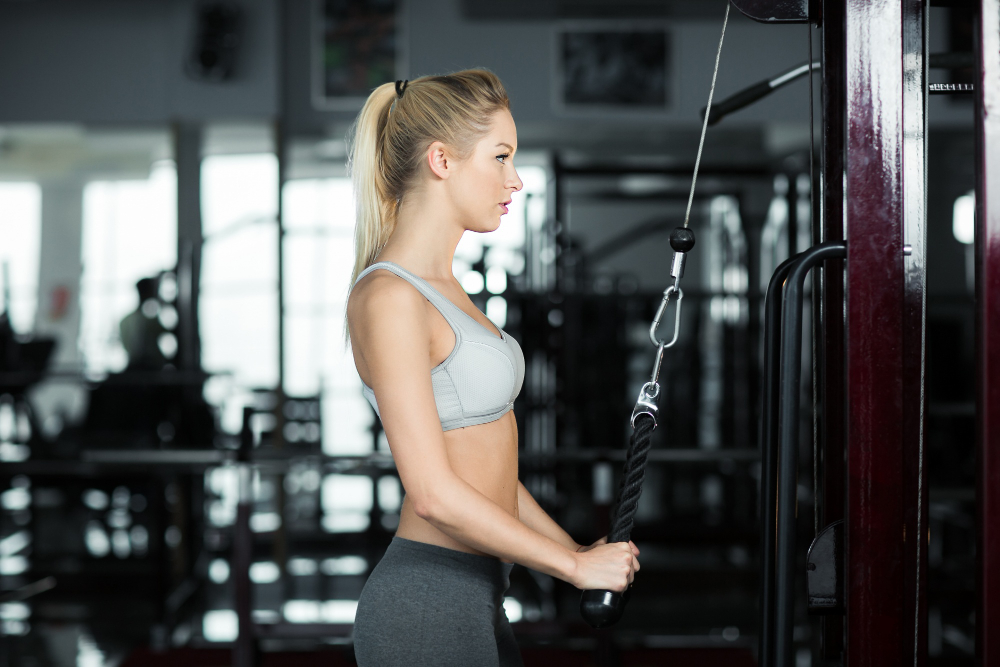Cable machines are widely used in commercial and home gyms because they offer consistent resistance and a wide range of motion. Many lifters rely on them to add variety and improve muscle control. Brands that supply equipment, such as Fitness Avenue cable machines, offer adjustable pulleys and multiple attachments that allow you to train nearly every muscle group. Understanding the exercises you can perform on a cable machine can help you build an effective and balanced workout routine.
What Upper-Body Exercises Can You Do on a Cable Machine?
Cable machines offer a wide range of upper-body movements for the chest, back, shoulders, and arms. Their adjustable pulleys allow you to target muscles from different angles, helping improve strength and stability.
Chest
- Cable Chest Fly – Performed with handles set at shoulder height or slightly above. The movement emphasizes horizontal adduction of the chest muscles.
- Low to High Fly – Starting with cables near the floor and pulling upward helps activate the upper chest.
- High-to-Low Fly – Cables are set high, and the movement sweeps downward, engaging the lower chest.
Back
- Lat Pulldown (using cable attachment) – Targets the lats and upper back by pulling the bar toward the chest.
- Seated Row – Performed on a low pulley with either a V-bar or straight bar.
- Straight-Arm Pulldown – Helps isolate the lats without involving the biceps.
Shoulders
- Cable Lateral Raise – Provides constant tension on the middle deltoids.
- Cable Front Raise – Targets the front deltoids through a controlled forward lift.
- Cable Rear Delt Fly – Works the rear deltoids and upper back.
Arms
- Cable Bicep Curl – Can be done with a straight bar, rope, or single handle.
- Cable Tricep Pushdown – Rope or straight bar attachments help work the triceps.
- Overhead Cable Tricep Extension – Stretches the long head of the triceps for deeper engagement.
What Lower-Body Exercises Can You Do on a Cable Machine?
Cable machines aren’t only for upper-body movements; they can also be used to strengthen the legs and glutes. Attach ankle straps or adjust the pulley height to perform controlled, targeted lower-body work.
Glutes
- Cable Kickback – A classic glute exercise using an ankle strap to extend the leg backward.
- Cable Hip Abduction – Targets the outer glutes and hips through side-leg lifts.
- Cable Pull-Through – Works the glutes and hamstrings by pulling the cable through the legs while hinging at the hips.
Legs
- Cable Squat – Holding the cable at chest height adds resistance to a traditional squat.
- Cable Lunges – Forward or reverse lunges with cable resistance challenge hip stability and leg strength.
- Cable Hamstring Curl – Can be done standing or kneeling with an ankle strap.
What Core Exercises Can You Do on a Cable Machine?
Cable machines offer adjustable resistance for core training, making it easier to target the abs and obliques without relying solely on body weight.
Abdominals
- Cable Crunch – Performed kneeling with a rope attachment to engage the upper and lower abs.
- Cable Reverse Crunch – Using ankle straps, you can pull upward to target the lower abdominal region.
Obliques
- Cable Woodchopper (High to Low) – A diagonal pulling motion that engages the obliques and deep core muscles.
- Cable Woodchopper (Low to High) – Similar movement pattern, but focuses on the opposite direction of rotation.
- Cable Side Bend – Single-arm movement that isolates the side of the torso.
What Full-Body Exercises Can You Do on a Cable Machine?
Cable machines allow for multi-joint movements that recruit several muscle groups at once. These can help build strength, coordination, and stability.
Cable Squat to Row
Combines a squat with a pulling motion to target the legs, glutes, and back.
Cable Deadlift
Using a low pulley, this movement mimics a standard deadlift with constant cable tension.
Cable Woodchopper Variations
Although often considered a core exercise, the woodchopper engages the legs, hips, and shoulders, making it a full-body rotational movement.
Cable Lunge with Press
Combines lower-body strength with upper-body pressing for a coordinated, compound motion.
What Benefits Come From Using a Cable Machine?
Cable machines provide a unique training experience thanks to adjustable angles, continuous resistance, and increased control. These features help improve strength and stability while reducing joint strain.
1. Controlled Range of Motion
The resistance stays consistent throughout the entire movement, reducing abrupt shifts and helping users focus on technique.
2. Adjustable Resistance Levels
You can increase or decrease resistance quickly, making the machine useful for progressive overload or fast-paced training.
3. Versatility Across Muscle Groups
Because you can adjust pulley height and swap attachments, a single machine can replace several pieces of equipment.
4. Suitable for All Fitness Levels
Beginners can perform exercises safely with lighter loads, and experienced lifters can increase intensity as needed.
In Summary
A cable machine offers an extensive range of upper-, lower-, core-, and full-body exercises. Its adjustable design makes it suitable for beginners and experienced lifters alike. By understanding the many exercises available and how each one targets different muscle groups, you can create varied and effective workouts that support your overall fitness goals.

